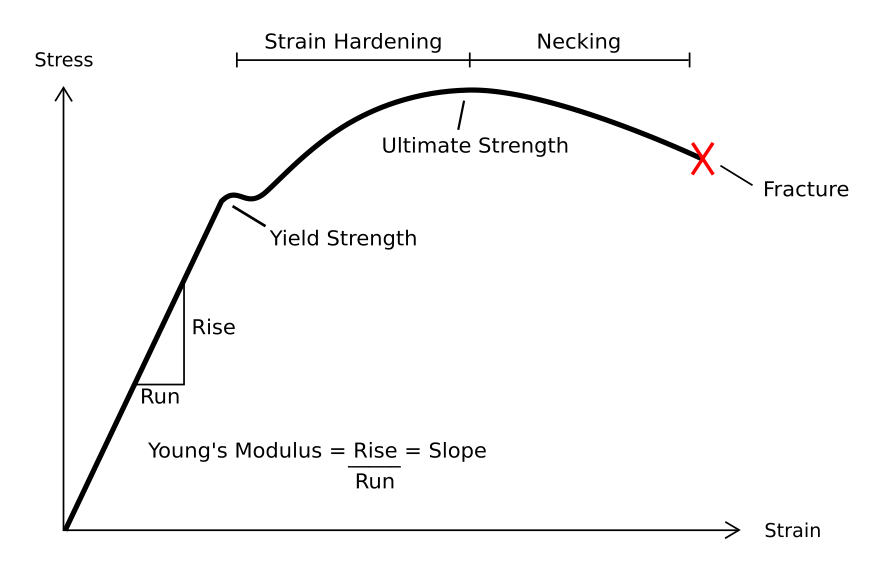|
Compression Set
The compression set (ASTM D395) of a material is the permanent deformation remaining after squashing it. In specific methods, temperatures and percent compression are specified. The term is normally applied to soft materials such as elastomers An elastomer is a polymer with viscoelasticity (i.e. both viscosity and elasticity) and with weak intermolecular forces, generally low Young's modulus and high failure strain compared with other materials. The term, a portmanteau of ''elastic ... and foams. Compression is normally measured in two ways: ''compression set'' ''A'' and ''compression set'' ''B''. Compression Set A This has the formal name compression set under constant force in air. In ''compression set A'' a force of 1.8 kN is applied to the specimen for a set time at a set temperature. ''Compression set A'' is defined as the percentage of original specimen thickness after the specimen has been left in normal (uncompressed) conditions for 30 minutes. CA, the ''compressio ... [...More Info...] [...Related Items...] OR: [Wikipedia] [Google] [Baidu] |
ASTM
ASTM International, formerly known as American Society for Testing and Materials, is an international standards organization that develops and publishes voluntary consensus technical standards for a wide range of materials, products, systems, and services. Some 12,575 ASTM voluntary consensus standards operate globally. The organization's headquarters is in West Conshohocken, Pennsylvania, about northwest of Philadelphia. It is founded in 1902 as the American Section of the International Association for Testing Materials (see also International Organization for Standardization). History A group of scientists and engineers, led by Charles Dudley, formed ASTM in 1898 to address the frequent rail breaks affecting the fast-growing railroad industry. The group developed a standard for the steel used to fabricate rails. Originally called the "American Society for Testing Materials" in 1902, it became the "American Society for Testing And Materials" in 1961. In 2001, ASTM off ... [...More Info...] [...Related Items...] OR: [Wikipedia] [Google] [Baidu] |
Deformation (engineering)
In engineering, deformation refers to the change in size or shape of an object. ''Displacements'' are the ''absolute'' change in position of a point on the object. Deflection is the relative change in external displacements on an object. Strain is the ''relative'' internal change in shape of an infinitesimally small cube of material and can be expressed as a non-dimensional change in length or angle of distortion of the cube. Strains are related to the forces acting on the cube, which are known as stress, by a stress-strain curve. The relationship between stress and strain is generally linear and reversible up until the yield point and the deformation is elastic. The linear relationship for a material is known as Young's modulus. Above the yield point, some degree of permanent distortion remains after unloading and is termed plastic deformation. The determination of the stress and strain throughout a solid object is given by the field of strength of materials and for a s ... [...More Info...] [...Related Items...] OR: [Wikipedia] [Google] [Baidu] |
Elastomers
An elastomer is a polymer with viscoelasticity (i.e. both viscosity and elasticity) and with weak intermolecular forces, generally low Young's modulus and high failure strain compared with other materials. The term, a portmanteau of ''elastic polymer'', is often used interchangeably with rubber, although the latter is preferred when referring to vulcanisates. Each of the monomers which link to form the polymer is usually a compound of several elements among carbon, hydrogen, oxygen and silicon. Elastomers are amorphous polymers maintained above their glass transition temperature, so that considerable molecular reconformation is feasible without breaking of covalent bonds. At ambient temperatures, such rubbers are thus relatively compliant ( E ≈ 3 M Pa) and deformable. Their primary uses are for seals, adhesives and molded flexible parts. Application areas for different types of rubber are manifold and cover segments as diverse as tires, soles for shoes, and dam ... [...More Info...] [...Related Items...] OR: [Wikipedia] [Google] [Baidu] |
Compression Set A Diagram
Compression may refer to: Physical science *Compression (physics), size reduction due to forces *Compression member, a structural element such as a column *Compressibility, susceptibility to compression *Gas compression *Compression ratio, of a combustion engine *Compression (geology) *Compression or compressive strength Information science *Data compression, reducing the data required for information *Audio compression (data), reducing the data required for audio * Bandwidth compression *Compression artifact, defect in data due to compression *Image compression, of digital images * Video compression *One-way compression function, a cryptographic primitive *Dynamic range compression, reducing audio dynamic range Medicine *Brain compression, a medical condition *Compression bandage *Pressing on the lower abdominal area in an intravenous pyelogram *Cold compression therapy, for minor injuries Other *Amplifier gain compression, due to nonlinearity *Compression (dance), several tech ... [...More Info...] [...Related Items...] OR: [Wikipedia] [Google] [Baidu] |
Kilo Newtons
The newton (symbol: N) is the unit of force in the International System of Units (SI). It is defined as 1 kg⋅m/s, the force which gives a mass of 1 kilogram an acceleration of 1 metre per second per second. It is named after Isaac Newton in recognition of his work on classical mechanics, specifically Newton's second law of motion. Definition A newton is defined as 1 kg⋅m/s (it is a derived unit which is defined in terms of the SI base units). One newton is therefore the force needed to accelerate one kilogram of mass at the rate of one metre per second squared in the direction of the applied force. The units "metre per second squared" can be understood as measuring a rate of change in velocity per unit of time, i.e. an increase in velocity by 1 metre per second every second. In 1946, Conférence Générale des Poids et Mesures (CGPM) Resolution 2 standardized the unit of force in the MKS system of units to be the amount needed to accelerate 1 kilogram of mass at the rate o ... [...More Info...] [...Related Items...] OR: [Wikipedia] [Google] [Baidu] |
Compression Set B Diagram
Compression may refer to: Physical science *Compression (physics), size reduction due to forces *Compression member, a structural element such as a column *Compressibility, susceptibility to compression *Gas compression *Compression ratio, of a combustion engine *Compression (geology) *Compression or compressive strength Information science *Data compression, reducing the data required for information *Audio compression (data), reducing the data required for audio *Bandwidth compression *Compression artifact, defect in data due to compression *Image compression, of digital images * Video compression *One-way compression function, a cryptographic primitive *Dynamic range compression, reducing audio dynamic range Medicine *Brain compression, a medical condition *Compression bandage *Pressing on the lower abdominal area in an intravenous pyelogram *Cold compression therapy, for minor injuries Other *Amplifier gain compression, due to nonlinearity *Compression (dance), several techn ... [...More Info...] [...Related Items...] OR: [Wikipedia] [Google] [Baidu] |

